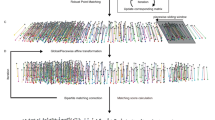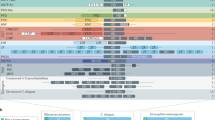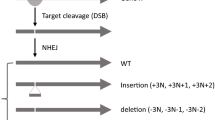Abstract
Maximum use should be made of information generated in the genome sequencing projects. Toward this end, we have initiated a genome sequence–based, expression pattern screen of genes predicted from the Caenorhabditis elegans genome sequence data. We examined β–galactosidase expression patterns in C. elegans lines transformed with lacZ reporter gene fusions constructed using predicted C. elegans gene promoter regions. Of the predicted genes in the cosmids analysed so far, 67% are amenable to the approach and 54% of examined genes yielded a developmental expression pattern. Expression pattern information is being made generally available using computer databases.
This is a preview of subscription content, access via your institution
Access options
Subscribe to this journal
Receive 12 print issues and online access
$209.00 per year
only $17.42 per issue
Buy this article
- Purchase on Springer Link
- Instant access to full article PDF
Prices may be subject to local taxes which are calculated during checkout
Similar content being viewed by others
References
Sulston, J. et al. The C. elegans genome sequencing project: a beginning. Nature 356, 37–41 (1992).
Wilson, R. et al. 2.2 Mb of contiguous nucleotide sequence from chromosome III of C. elegans. Nature 368, 32–38 (1994).
Coulson, A., Sulston, J., Brenner, S. & Kam, J. Towards a physical map of the genome of the nematode Caenorhabditis elegans. Proc. natn. Acad. Sci. U.S.A. 83, 7821–7825 (1986).
Coulson, A., Waterston, R., Kiff, J., Sulston, J. & Kohara, Y. Genome linking with yeast artificial chromosomes. Nature 335, 184–186 (1988).
Kenyon, C. The nematode C. elegans. Science 240, 1448–1452 (1988).
Wood, W.B. & Edgar, L.G. Patterning in the C. elegans embryo. Trend. Genet. 10, 49–54 (1994).
Hill, D.P. & Wurst, W. Gene and enhancer trapping: mutagenic strategies for developmental studies. Curr. Top. dev. Biol. 28, 181–205 (1993).
Fields, C. Information content of Caenorhabditis elegans splice site sequences varies with irrtron length. Nucl. Acids Res. 18, 1509–1512 (1990).
Fire, A., Harrison, S.W. & Dixon, D. A modular set of lacZ fusion vectors for studying gene expression in Caenorhabditis elegans. Gene 93, 189–98 (1990).
White, J.G., Southgate, E., Thomson, J.N. & Brenner, S. The structure of the nervous system of the nematode Caenorhabditis elegans. Phil. Trans. Roy. Soc. London. 314, 1–340 (1986).
Sulston, J.E. & Horvitz, H.R. Post-embryonic cell lineages of the nematode, Caenorhabditis elegans. Dev. Biol. 56, 110–156 (1977).
Hope, I.A. Promoter trapping in Caenorhabditis elegans. Development 113, 399–408 (1991).
Young, J.M. and Hope, I.A. Molecular markers of differentiation in Caenorhabditis elegans obtained by promoter trapping. Devl. Dynam. 196, 124–132 (1993).
Bork, P., Ouzounis, C. & Sander, C. From genome sequences to protein function. Curr. Opin. struct. Biol. 4, 393–403 (1994).
Zwaal, R.R., Broeks, A., van Meurs, J., Groenin, J.T.M. & Plasterk, R.H.A. Target-selected gene inactivation in Caenorhabditis elegans by using a frozen transposon insertion mutant bank. Proc. natn. Acad. Sci. U.S.A 90, 7431–7435 (1993).
Orr, S.L. et al. Isolation of unknown genes from human bone-marrow by differential screening and single pass cDNA sequence determination. Proc. natn. Acad. Sci. U.S.A 91, 11869–11873 (1994).
Matsubara, K. & Okubo, K. cDNA analyses in the human genome project. Gene 135, 265–274 (1993).
Okkema, P.G., Harrison, S.W., Plunger, V., Aryans, A. & Fire, A. Sequence requirements for myosin gene expression and regulation in Caenorhabditis elegans. Genetics 135, 385–404 (1993).
Krause, M., Harrison, S.W., Xu, S.-Q., Chen, L. & Fire, A. Elements regulating cell- and stage-specific expression of the C. elegans MyoD family homolog hlh-1. Devl. Biol. 166, 133–148 (1994).
Evans, T.C., Crittenden, S.L., Kodoyianni, V. & Kimble, J. Translational control of maternal glp-1 mRNA establishes an asymmetry in the C. elegans embryo. Cell 77, 183–194 (1994).
Ahringer, J. & Kimble, J. Control of the sperm-oocyte switch in Caenorhabditis elegans hermaphrodites by the fem-3 3′ untranslated region. Nature 349, 346–348 (1991).
Land, M., Islas-Trejo, A., Freedman, J.H. & Rubin, C.S. Structure and expression of a novel, neuronal protein kinase C (PKC1B) from Caenorhabditis elegans. J. biol. Chem. 269, 9234–9244 (1994).
Krause, M., Fire, A., Harrison, S.W., Priess, J. & Weintraub, H. CeMyoD accumulation defines the body wall muscle cell fate during C. elegans embryogenesis. Cell 63, 907–919 (1990).
Hamelin, M., Scott, I.M., Way, J.C. & Culotti, J.G. The mec-7 β-tubulin gene of Caenorhabditis elegans is expressed in the touch receptor neurons. EMBO J. 11, 2885–2893 (1992).
Hill, R.J. & Sternberg, R.W. The gene lin-3 encodes an inductive signal for vulval development in C. elegans. Nature 358, 470–476 (1992).
Cowing, D.W. & Kenyon, C. Expression of the homeotic gene mab-5 during Caenorhabditis elegans embryogenesis. Development 116, 481–490 (1992).
Mitani, S., Du, H., Hall, D.H., Driscoll, M. & Chalfie, M. Combinatorial control of touch receptor neuron expression in Caenorhabditis elegans. Development 119, 773–783 (1993).
Lincke, C.R., Broeks, A., The, I., Plasterk, R.H.A. & Borst, R. The expression of two P-glycoprotein (pgp) genes in transgenic Caenorhabditis elegans is confined to intestinal cells. EMBO J. 12, 1615–1620 (1993).
Freedman, J.H., Slice, L.W., Dixon, D., Fire, A. & Rubin, C.S. The novel metallothionein genes of Caenorhabditis elegans. J. biol. Chem. 268, 2554–2564 (1993).
Sfringham, E.G., Dixon, O.K., Jones, D. & Candido, E.R.M. Temporal and Spatial Expression Patterns of the Small Heat Shock (hsp76) genes in transgenic Caenorhabditis elegans. Molec. Biol. Cell 3, 221–233 (1992).
Way, J.C., Wang, L., Run, J-Q. & Wang, A. The mec-3 gene contains cis-acting elements mediating positive and negative regulation in cells produced by asymmetric cell division in C. elegans. Genes Dev. 5, 2199–2211 (1991).
MacMorris, M. et al. Regulation of vitellogenin gene expression in transgenic Caenorhabditis elegans: short sequences required for activation of the vit-2 promoter. Molec. cell. Biol. 12, 1652–1662 (1992).
Spieth, J., Brooke, G., Kuersten, S., Lea, K. & Blumenthal, T. Operons in C. elegans: Polycistronic mRNA precursors are processed by transsplicing of SL2 to downstream coding regions. Cell 73, 521–532 (1993).
Zorio, D.A.R., Cheng, N.N., Blumenthal, T. & Spieth, J. Operons as a common form of chromosomal organization in C. elegans. Nature 372, 270–272 (1994).
Sulston, J., Dew, M. & Brenner, S. Dopaminergic neurons in the nematode Caenorhabditis elegans. J. comp. Neur. 163, 215–226 (1975).
White, J.G. The anatomy, in The nematode, Caenorhabditis elegans. (ed. Wood, W.B.) 81–122. (Cold Spring Harbor, New York, 1988).
Brenner, S. The genetics of Caenorhabditis elegans. Genetics 77, 71–54 (1974).
Fire, A. Integrative transformation of Caenorhabditis elegans. EMBO J. 5, 2673–2680 (1986).
Melta, C.C., Kramer, J.M., Stinchcomb, D. & Ambros, V. Efficient gene transfer in C. elegans: extrachromosomal maintenance and integration of transforming sequences. EMBO J. 10, 3959–3970 (1991).
Albertson, D.G. & Thomson, J.N. The pharynx of Caenorhabditis elegans. Phil. Trans. R. Soc. London 275, 299–325 (1976).
Nelson, F.K., Albert, R.S. & Riddle, D.L. Fine structure of the Caenorhabditis elegans secretory-excretory system. J. Ultrastruct. Res. 82, 156–171 (1983).
Sulston, J.E., Schierenberg, E., White, J.G. & Thomson, J.N. The embryonic cell lineage of the nematode Caenorhabditis elegans. Devl. Biol. 100, 64–119 (1983).
Author information
Authors and Affiliations
Rights and permissions
About this article
Cite this article
Lynch, A., Briggs, D. & Hope, I. Developmental expression pattern screen for genes predicted in the C. elegans genome sequencing project. Nat Genet 11, 309–313 (1995). https://doi.org/10.1038/ng1195-309
Received:
Accepted:
Issue Date:
DOI: https://doi.org/10.1038/ng1195-309
This article is cited by
-
The exceptional stem cell system of Macrostomum lignano: Screening for gene expression and studying cell proliferation by hydroxyurea treatment and irradiation
Frontiers in Zoology (2007)
-
Evolutionary innovation of the excretory system in Caenorhabditis elegans
Nature Genetics (2004)
-
Functional exploration of the C. elegans genome using DNA microarrays
Nature Genetics (2002)
-
Protein interaction maps for model organisms
Nature Reviews Molecular Cell Biology (2001)
-
http://C.Elegans: Mining the functional genomic landscape
Nature Reviews Genetics (2001)



